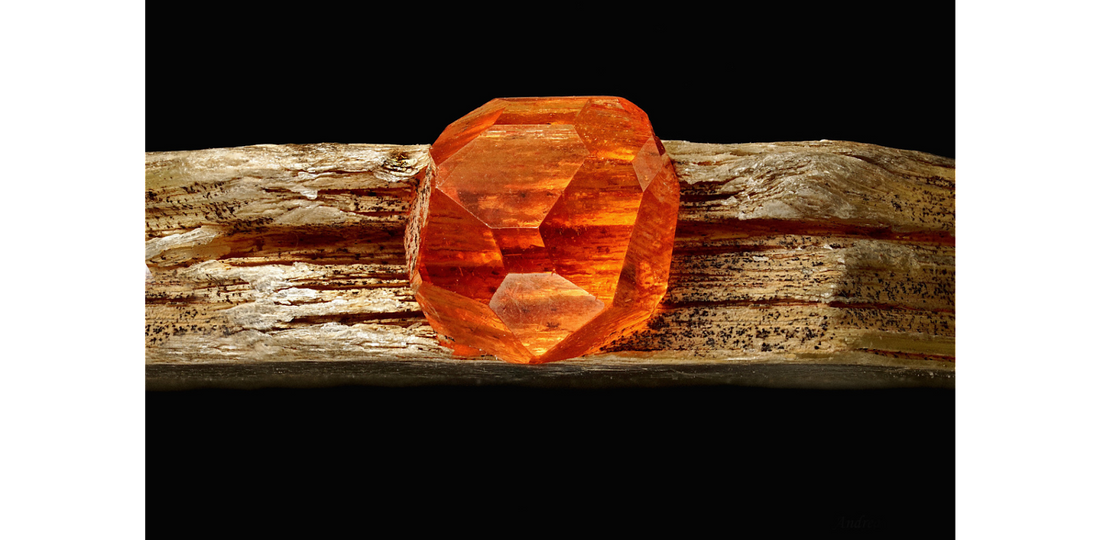
The Colours of Garnet, Part 2: Pyralspite Garnets
Share
By Yaĝé Enigmus
In the jewellery trade, six nesosilicate garnet minerals are valued as gemstones. These minerals each display their own ranges of colour, and some species also occur as distinct varieties with additional character. The six major gem garnets are divided into two sets based on which solid solution series they typically take part in, with each series having a name derived from the names of its participant species. The garnet series most frequently encountered is the “pyralspite” garnets, named fir each of its garnet types combined: pyrope garnet, almandine garnet, and spessartine (a.k.a. spessartite) garnet.
Pyrope Garnet

Pyrope garnet is the magnesium aluminum nesosilicate member of the garnet group, and one of two garnet species that make up the majority of “red garnet” gemstones. The name for this garnet mineral is derived from the Greek “pyropus” meaning “fire eye” in reference to its red colouration, which often ranges from rose red to blood red. The red colouration of pyrope garnet comes from impurities of ferrous iron (Fe2+) within its crystal structure, while pure pyrope is colourless; pyrope garnet’s colourless nature and its thinly distributed chromophores often result in softer red hues which in some cases may lean towards pink. Although some crystals show zones of colourless pyrope, entire crystals of pure pyrope garnet have never been found in nature, and the purest gem-grade crystals known tested at only 83% pure pyrope content. Pyrope garnet may also contain impurities of trivalent chromium (Cr3+) which often enhance the richness of the reds displayed by this stone.
Almandine Garnet

Almandine garnet is the iron aluminum nesosilicate member of the garnet group, and the second major species that is colloquially known as “red garnet”, ranging in colour from blood red to iron red. More common than pyrope garnet, almandine garnet makes up a component of most deep red garnet gemstones. This name for this garnet mineral is loosely derived from the term “alabandicus”, which was famously used by Pliny the Elder to describe gemstones associated with the ancient Greek town of Alabanda in what is now western Turkey, although it is unknown whether or not these stones were red garnets; almandine garnet is also thought to be the stone most frequently referred to in the ancient world as “carbuncle”, a term used for multiple deep red gemstones which is derived from the latin term “carbunculus” meant to describe a small coal or ember. The colour of almandine garnet derives directly from the ferrous iron (Fe2+) which is part of its crystal structure. Impurities of ferric iron (Fe3+) may also lend tones of burgundy or auburn to almandine’s color via an iron to iron charge transfer (Fe2+-Fe3+). Similarly to pyrope garnet, trivalent chromium (Cr3+) impurities may intensify the colour of this stone.
Star Garnet

In some cases almandine garnet may form with dense rutile inclusions that are suitably aligned to produce chatoyancy. Typically such stones contain multiple chatoyant axes and consequently display asterism. These “star garnets” usually exhibit four-ray stars, but may also exhibit six-ray stars. In rare cases only one axis of chatoyancy is present, with such stones being referred to simply as “cat’s eye garnet”. Pyrope garnets are also capable of displaying chatoyancy, but this occurs less frequently than in almandine garnet. Star garnets often form as larger crystals with darker body colour, and are almost exclusively cut as a cabochon to display their optical phenomena.
Spessartine (Spessartite) Garnet

Spessartine garnet is the manganese aluminum nesosilicate member of the garnet group, sometimes also referred to as “spessartite” in the gem trade, a term which in actuality is meant to designate a type of lamprophyre rock bearing both feldspar and hornblende. Spessartine is named after the Spessart mittelgebirge in Bavaria, Germany where it was first described by Western scientists. This garnet mineral ranges in colour from burnt orange-red to the aptly named hues of “mandarin orange” and “fanta orange”. The bright oranges this garnet displays are produced by the divalent manganese (Mn2+) that is part of its pure crystal structure, with impurities of ferrous iron (Fe2+) imparting red hues. In some manganese-rich stones, small amounts of trivalent manganese (Mn3+) may be present, which can add yellow-orange and/or peach-orange tints to spessartine’s fanta colouration.

A “mandarin orange” spessartine garnet crystal on muscovite mica matrix from Gilgit-Baltistan, Pakistan. Image: Mindat/ Andreas Schmid
Learn about uvarovite garnet and grossular garnet in the next part of this series.
The Skyjems collection features vibrant spessartite garnets! Check out some of our Fanta orange gemstones:
|
|
© Yaĝé Enigmus












